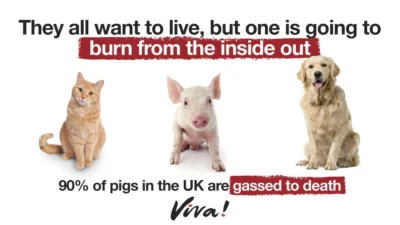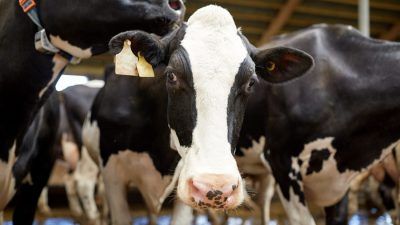Is Dairy Healthy and Do Humans Need it?

Drinking milk beyond weaning is neither natural, normal or necessary – you don’t need dairy for good health!
The idea that humans should drink milk beyond infancy, especially from other species, is a relatively recent phenomenon in our evolutionary history. While milk is undeniably crucial for infant growth and development across all 5,000 or so mammalian species, it’s natural for mammals to stop drinking milk as they grow – all mammals go through a natural weaning process. We are, in fact, the only mammal that continues to consume milk after weaning, and uniquely, the milk of another species.
Consider the notion from a different perspective: if a friend told you they were suckling from their pet dog or cat, or even directly from a cow, it would likely strike you as unusual, if not unnatural. This highlights what has become an ingrained idea of what is considered ‘normal’ and ‘natural’ for humans. From an evolutionary standpoint, the sustained consumption of dairy beyond weaning is neither natural, normal, nor necessary for optimal human health.

Cow’s milk: ideal for calves not humans
The composition of milk varies widely from animal to animal, providing the perfect first food for the young of that species. Cow’s milk is very different from human milk – which is why all major health bodies warn that you must not give off-the-shelf cow’s milk to a baby – it has to be changed into special infant formula which attempts to replicate the nutrient profile of human milk.
Cow’s milk is ‘designed’ to fuel rapid growth so that a calf can triple his or her weight within a year to a whopping 300 to 400 kilograms. It is perfect for a calf but can be unhealthy and even harmful for humans.
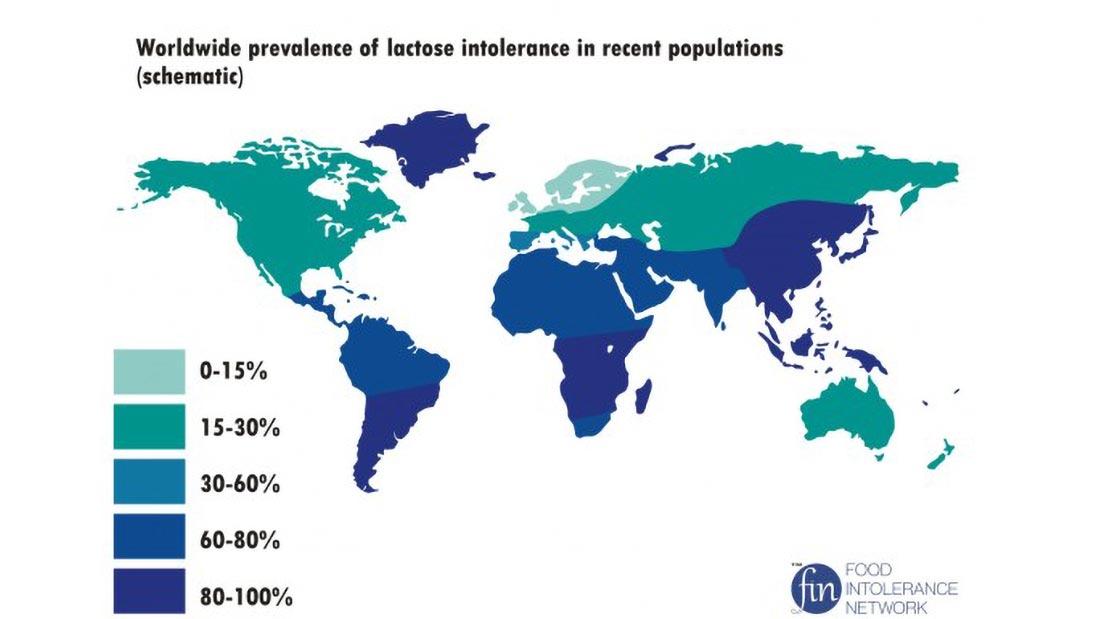
Lactose intolerance
Did you know that around 70 per cent of the world’s population are lactose intolerant? For example, most people in China, Vietnam, Thailand and Japan are lactose intolerant. This simply means they can’t digest lactose – the sugar in milk. Everyone has the ability to digest it when they are born, but most people lose this ability after weaning. If someone with lactose intolerance drinks milk, they may experience diarrhoea, a bloated and painful stomach, wind and, on some occasions, nausea and vomiting. Even in the UK, lactose intolerance is the most common adverse reaction to cow’s milk among adolescents and adults with an estimated eight per cent of people affected. Lactose intolerance is the normal state for most people – adult mammals (including humans) do not normally need to digest lactose as they don’t suckle beyond weaning. It’s only possible for some people due to random genetic mutations that occurred several thousand years ago. These mutations offered a selective advantage to populations using dairy products and can be traced back to a minority of pastoral tribes including the Tuareg in West and North Africa; the Fulani in West Africa; the Tutsi of Rwanda and Burundi; some South Asian groups including those in northern India and Pakistan; and various European populations, particularly Northern and Northwestern Europeans. Find our more about lactose intolerance and how it differs from cow’s milk allergy here.
Every hour is cocktail hour!
In every glass of milk or bite of cheese, there is a cocktail of hormones and growth factors. A substantial amount of milk produced in the UK comes from cows that are either currently pregnant or have recently given birth. This is because dairy cows are usually re-impregnated within two to three months after calving and will then be milked for about seven months before entering a two-month ‘dry period’ just before giving birth and then the cycle begins again. This means that cows are pregnant for most of the time they are being milked. Research shows, hormone levels in milk increase during pregnancy. These hormones and growth factors carry important messages from mother to offspring directing the rapid growth needed by a young calf but not by an adult human.
Taking the pus
Another undesirable component, milk containing up to 400 million somatic white blood cells per litre is legally allowed to be sold in the UK for human consumption. Why so much? Because modern, intensive dairy farming ensures that 50 to 70 of every 100 British dairy cows each year suffer with mastitis – a painful infection of the udders. Their immune system sends white somatic cells to battle the infection. These, and dead tissue, can ooze into the milk. The worse the infection, the higher the somatic cell count, reflecting the cow’s almost constant fight against bacterial infection. Pus is made up of white blood cells, bacteria and dead udder tissue cells and some of it finds its way into her milk – although they tell us it’s not pus!
Bone health
Worried about your bones? Don’t be, most people in the world don’t drink milk and their bones are not crumbling away, while some countries that drink the most milk, in Scandinavia and the US for example, are among those with the highest fracture rates. You don’t need dairy. Cow’s milk is not the best source of calcium; our bones benefit more from plant sources. Weight-bearing exercise, such as walking, running and dancing, is the most important factor for maintaining healthy bones, followed by improving diet (plenty of fruit, vegetables, wholegrains, pulses, seeds and nuts) and lifestyle. To protect your bones – use ‘em or lose ‘em! Read more about bone health here and here.
Mending a broken heart
Heart and circulatory diseases cause around a quarter of all deaths in the UK, more than 170,000 deaths each year – one every three minutes. Heart disease occurs when arteries carrying blood to the heart become blocked. Gradually, they become furred with ‘plaques’ – a thick sludge formed from cholesterol and other substances. Unhealthy saturated fat found in dairy (hard cheese, cream, ice cream, milk chocolate and butter), red and white meats and eggs, as well as hydrogenated fats in junk foods, raise ‘bad’ cholesterol levels in the blood and increase the risk of heart disease. Read more about heart health here.
Not cool for kids
Acne, allergies and obesity are all linked to dairy. Childhood diabetes (type 1) is increasing dramatically in younger children; early exposure to cow’s milk in some children is a recognised trigger. The number of children and young people diagnosed with type 2 diabetes is also on the rise. Lack of exercise and poor diets, including high-fat dairy products, are contributing to the problem – four-cheese pizzas do you no favours!
Milk – the wrong stuff
Drinking milk is unnatural for us. Many people find milk hard to digest, suffering from discomfort and pain. Despite relentless claims by the dairy industry, milk is neither the only nor the best source of calcium. Beans, lentils, broccoli, kale, watercress, nuts, seeds, soya and other plant foods are better and healthier sources. Ditching dairy products has never been easier as supermarkets and other food shops now stock a wide selection of delicious and nutritious dairy-free alternatives to milk, yoghurt, ice cream, margarine and cheese!
Source: Food and Agriculture Organisation of the United Nations (2024) – processed by Our World in Data
Around 70 per cent of the world’s population do not drink milk, but among those who do, the pattern of consumption varies widely between countries. Data collected by the Food and Agriculture Organisation of the United Nations (FAO) provides figures for the consumption of milk (excluding butter) in kilograms per person per year for over 170 countries. The chart above shows the milk supply per person per year (2022) for a range of countries.
The level of milk and dairy product consumption varies widely between countries. The average amount globally is around 82 kilograms. The highest levels are seen in Europe, led by countries such as Denmark, Ireland and Switzerland and the lowest levels are seen in Africa and Asia with such low levels in some countries (eg 4.8 kilograms in Nigeria and 2.2 in Mozambique) that it is reasonable to assume that many people in these countries do not consume any milk or milk products.
So, most people in the world do not drink milk; their reasons may be cultural, economic, historical or biological. Despite this, many people continue to argue that milk is a fundamental component of a healthy diet when it so clearly is not.
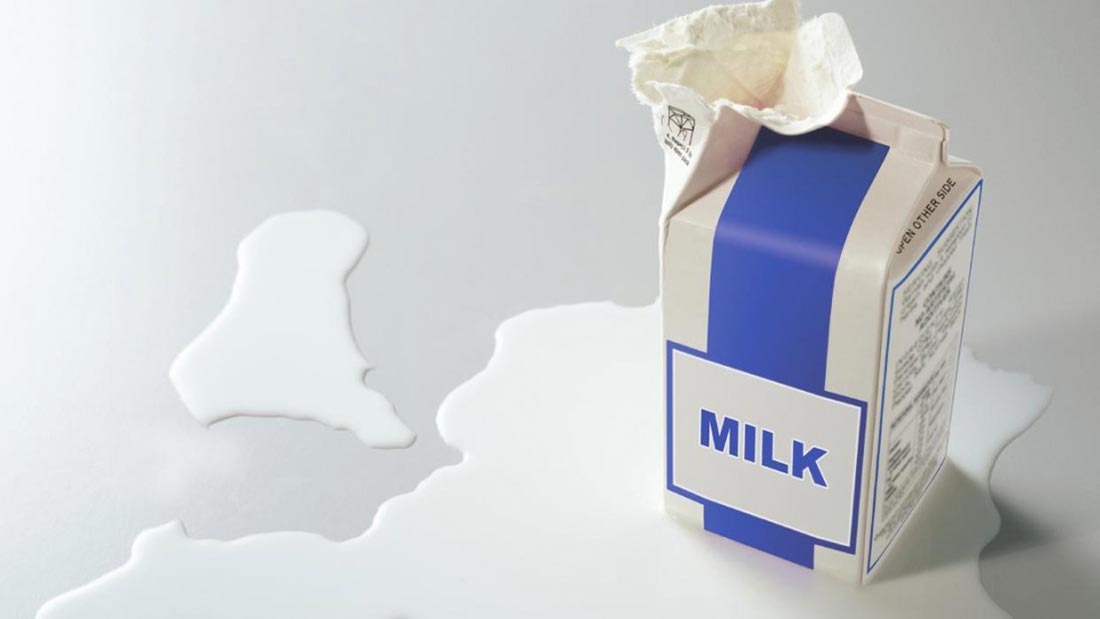
Adverts for dairy products are very inventive but rarely tell you the real facts. We all know milk contains calcium but what else is in it and how does it affect your health? Here are the facts.
Water
The main component of milk is water, around 87 per cent and even more in skim milk, over 90 per cent. Water is necessary for the newborn calf and also serves as a carrier for all the other ingredients in milk. When dairy proponents criticise plant milks for containing a lot of water, they’re conveniently forgetting that dairy milk shares the same characteristic!
Sugar
Milk naturally contains sugar – lactose – about five grams per 100 millilitres. Lactose is a sugar that serves as the main source of energy for the newborn calf.
However, for lactose to be digested the enzyme lactase is necessary. All human babies have this enzyme but only a minority (around 30 per cent) retain it after weaning. In fact, most of the world’s population (around 70 per cent) are unable to digest lactose after infancy and are therefore described as lactose intolerant.
Protein
The amount of protein in cow’s whole milk is around 3.4 grams per 100 grams (3.5 grams in semi-skimmed milk) while it is only 1.3 grams per 100 grams in human milk. The proteins in milk can be divided into two categories – caseins and whey proteins. In humans, caseins can be difficult to digest, may cause cow’s milk allergy and have been linked to type 1 diabetes. Caseins are so tough they are even used as a basis of some glues! The ratio of caseins to whey proteins is 40:60 in mature human milk but it is 80:20 in cow’s milk. So, human milk is richer in whey proteins, especially early on, making it easier to digest for infants, while cow’s milk is dominated by casein.
Calves need extra protein because they need to grow fast. Human babies, on the other hand, need less protein and more fat to fuel brain development.
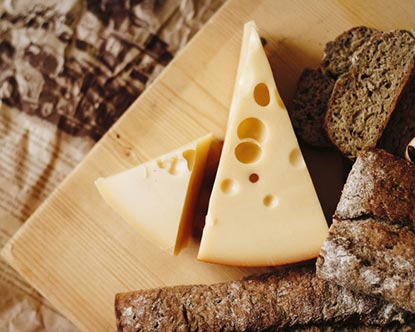
Fat
Most of the fat in whole milk and many dairy products is the unhealthy saturated type. Even though low-fat milk products contain less fat overall, much of the fat in them is saturated. This ‘bad’ fat is completely unnecessary for humans and increases the risk of many diseases including heart disease, stroke, diabetes, metabolic syndrome and has been linked to several types of cancer. Some dairy products, such as butter and cheese, are the among the biggest saturated fat contributors in Western diets, contributing to the current obesity epidemic.
Cow’s milk contains only a small amount of polyunsaturated fats that are not only essential for the human body but also posses a wide range of beneficial properties. These are abundant in plant foods and some plant milks are also a good source.
Vitamins and minerals
Cow’s milk contains significant amounts of sodium, potassium, calcium, magnesium, phosphorus and chloride and lower levels of zinc, selenium, iodine and trace amounts of iron, copper and manganese. Vitamins in cow’s milk include retinol, carotene, vitamin E, thiamine, riboflavin, niacin, vitamin B6, vitamin B12, folate, pantothenate, biotin, vitamin C and trace amounts of vitamin D. In the US, but not the UK, cow’s milk is fortified with vitamin D; this leads to some confusion with industry pundits mistakenly saying that in the UK, cow’s milk is a good source of vitamin D – it is not!
Although cow’s milk contains all these nutrients, it is important to note that many are contained at low levels. Furthermore, the mineral content is so out of balance with human biochemistry that it is difficult for us to absorb the optimum amounts required for health. For example, our bodies absorb calcium better from kale than from milk.
Hormones
As described above, cow’s milk naturally contains a cocktail of hormones and growth factors, including IGF-1 (insulin-like growth factor 1), oestrogen and progesterone, adrenal, pituitary, hypothalamic and other hormones. They help a calf grow to adult size in just over one year but humans grow at a much slower rate – brain development is more important in the first year for a human baby.
IGF wot not?
IGF-1 stands for insulin-like growth factor 1. It is a growth hormone that controls growth and development in both cows and people but each species has very different rates of growth. Meat and dairy products are linked to raised levels of IGF-1, and higher IGF-1 levels are linked to a higher risk of various cancers including those of the breast and prostate.
Vegans tend to have lower levels of IGF-1 in their blood. One study found that, compared with meat-eaters and vegetarians, vegan women had 13 per cent lower levels of IGF-1. In another study, vegan men had IGF-1 levels nine per cent lower than meat-eaters and vegetarians and this difference may be considered enough to lower the risk of prostate cancer. The intake of animal protein was linked with higher IGF-1 levels and diet explained most of the differences in IGF-1 levels between the groups.
The composition of milk varies widely from animal to animal, providing the perfect first food for the young of each particular species. A seal’s milk, for example, is extraordinarily fatty; 50 per cent fat compared to just three to five per cent fat in human milk. This is so that seal pups can grow very quickly, depositing a thick layer of blubber that will protect them from the cold and sustain them as they learn to hunt for themselves. Just as we are different from seals, we are different from cows too! It won’t surprise you, then, that cow’s milk is very different from human milk – which is why you mustn’t give off-the-shelf cow’s milk to infants under the age of one and why cow’s milk must be reformulated into infant formula, in an attempt to replicate human milk.
Ever wondered how dairy products and plant-based milks compare? We’ve done all the hard work for you!
Sugar with your milk?
As you can see in the table below, cow’s milk contains more sugar than most plant milks. Milk sugar – lactose – is a natural component of mammalian milk. It’s a simple sugar, which means it breaks down quickly and is quickly absorbed by your body in the same way as table sugar.
On the other hand, unsweetened plant milks contain very little sugar and even the sweetened varieties are often sweetened with apple juice, which is absorbed more slowly.
The lowest in sugar: soya, almond and hemp milks
| Nutrient/100g | Cow's milk (semi-skimmed) | Soya milk | Almond milk | Oat milk | Coconut milk |
|---|---|---|---|---|---|
| Total fat | 1.8g | 1.8g | 1.1g | 1.5g | 0.9-1.2g |
| Saturated fat | 1-1.3g | 0.3g | 0.1g | 0.2g | 0.9-1.1g |
| Polyunsaturated (essential) fats | 0-0.1g | 1.1g | 0.3g | 0.9g | 0g |
| Protein | 3-4g | 3.3g | 0.5g | 0.8g | 0.1-0.2g |
| Sugar (unsweetened) Sugar (sweetened) | 4.8g - | 0g 2.5g | 0g 2.4g | 0g 3.2g | 0g 1.9g |
| Fibre | 0g | 0.6g | 0.3g | 1.4g | 0-0.1g |
| Calcium | 120mg | 120mg | 120mg | 120mg | 120mg |
Floating fats
Cow’s milk and dairy products contain saturated ‘bad’ fats which increase the risk of heart disease and stroke. All other plant milks (with the exception of coconut milk) have a healthier fat profile. Soya milk also comes with an extra dose of essential omega-3 fats. Oat and almond milk have the lowest saturated fat content.
Lowest in fat: almond and oat milk
Packing protein
Protein levels vary and although cow’s milk has about the same protein content as soya milk, cow’s milk proteins (whey and casein) may be difficult for some people to digest. Soya not only contains a good amount of protein but it’s healthier, it lowers cholesterol and may reduce the risk of breast cancer.
Best for protein: soya milk
Liquid calcium
The amount of calcium you get from fortified plant milks is usually the same as from cow’s milk. Not all plant milks are fortified though, so check the carton. The calcium in dairy milk is why we’ve been told to drink the white stuff so don’t forget that plant milks supply the same amount but without the hidden nasties.
Best for calcium: all fortified plant milks
Roughage in your drink
All plant milks contain some fibre, which is essential for good health, whilst dairy milk contains none. Fibre helps keep your digestive tract healthy and can slow down sugar digestion. Soya, almond and oat milk are best for fibre but oat milk is the clear overall winner.
Best for fibre: oat milk
Environmental impact
It takes over one thousand litres of water to produce one litre of cow’s milk. To produce the same amount of soya milk, you need just 297 litres of water – and even less for other crops such as oats! Almonds drink a bit more but they’re certainly not the culprit behind California’s water crises, as some tabloids claimed. Almonds may not be as environmentally friendly as the vast majority of plant foods, but they still have a lower environmental impact than meat and dairy. See the environmental impacts of different milks here.
And the winner is?
It’s impossible to pick which plant milk is the best. Ultimately, it comes down to taste because you’re most likely to stick with something you enjoy drinking! The fact is, all plant milks are not just more ethical and sustainable than cow’s milk, they’re also healthier.
Dairy yoghurt vs soya yoghurt
When it comes to yoghurt, soya ones are by far the best – providing good amounts of protein, calcium, healthy fat and fibre:
| Nutrient/100g | Plain low-fat dairy yoghurt | Alpro plain soya |
|---|---|---|
| Total fat | 1g | 2.8g |
| Saturated fat | 0.7g | 0.4g |
| Polyunsaturated (essential) fats | 0g | 1.4g |
| Protein | 4.8g | 4.0g |
| Sugar | 7.5g | 2.2g |
| Fibre | 0g | 0.9g |
| Calcium | 162mg | 120mg |
The only thing to watch when it comes to non-dairy yoghurts are some coconut ones which can have a high fat content. They are OK for an occasional treat but try not to eat them too often.

